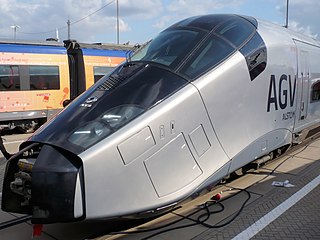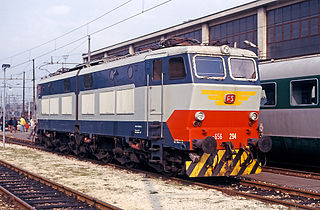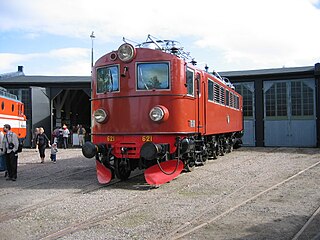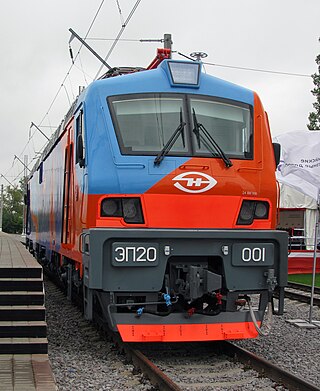
The AGV is a standard gauge, high-speed, electric multiple-unit train designed and built by Alstom.

The FS E.645 and E.646 are two classes of similar electric locomotives used on Italian railways. They were introduced during the 1950s and they were retired in 2009.

The E.412 class is a batch of multi-role electric locomotives built for the mountain lines, particularly for the northern Italian lines of the Brenner pass. They are known as Brenner or Brennerlok locomotives. 28 units from both the groups have been acquired by Trenitalia, as part of a process of simplifying rail operation between Italy, Switzerland, Austria and Germany. The locomotives are qualified for running on French rails, too, making the E.412s potentially fit for service on most European lines except the high-speed rail lines.

The FS E.636 is a class of Italian articulated electric locomotives. They were introduced in the course of the 1940s until the 1960s, and have been decommissioned since 2006. They have been one of the most numerous Italian locomotive groups, and have been widely employed during their long career, hauling every type of train, ranging from freight to long range passenger services. Their introduction also saw the employment of some revolutionary design concepts, such as the articulated carbody and the three bogies scheme.

The class E 10 is an electric locomotive of the Deutsche Bundesbahn, introduced in 1952. It belongs to the Einheits-Elektrolokomotiven program and was built for express passenger service. In 1968 the series was redesignated as class 110 (E10) and class 112 (E10.12). In 1988 the last series of class 112 locomotives were designated as class 114, and in 1991 the remaining locomotives of class 112 were designated as class 113. In 2006 38 locomotives were designated as class 115.

The Class E.656 is an Italian articulated rheostatic-type electric locomotive built from 1975 to 1989. An evolution of the E.646, they are mixed traffic locomotives, and have been used on every kind of train, ranging from freight to intercity passenger transport.

The FS E.444 is a class of Italian railways electric locomotives. They were introduced in the course of the 1960s until 1975. Starting from 1989, all E.444s were upgraded as E.444R.

The E.464 is a class of Italian railways electric locomotives. They were introduced in the course of the 1990s for hauling light trains, especially for commuter service. They were acquired by FS Trenitalia to replace the old E.424 and E.646, dating from the 1940s and 1950s. The class was originally designed by ABB Trazione, later ADTranz, and produced in the Italian plant of Vado Ligure.

The FS E.625 and E.626 are two classes of Italian electric locomotives produced for the Ferrovie dello Stato. They were introduced in the course of the 1920s and remained in service until the 1990s. The E.626 was the first locomotive fed by 3,000 V DC overhead line in Italy.

The FS E.424 is a class of Italian railways electric locomotives. They were built in 1943-1951 and have been decommissioned in 2008.

The SNCF Class BB 36000 locomotives are a class of triple voltage 4 axle twin bogie electric locomotives built by GEC-Alsthom between 1996 and 2001 for SNCF.

E.402A/B is a class of electric locomotives mainly used on medium speed passenger trains by the Italian railway company FS Trenitalia.

Littera F was a class of electric locomotives operated by the Swedish state railways (SJ) between 1942 and 1983. Twenty-four F-locomotives were constructed and delivered between 1942 and 1949. The design was a rigid-framed locomotive with quill drive and the axle arrangement 1′Do1′, inspired by the German type E 18. The F-locomotives pulled express passenger trains and express freight trains.

The FS Class E.550 was a class of three-phase electric locomotive used in Italy, introduced in the 20th century, which remained in service until 1965.

The EP20 (ЭП20) is a type of 6 axle Bo'Bo'Bo' electric passenger locomotive being built for Russian Railways by Transmashholding's Novocherkassk Electric Locomotive Plant. The locomotive was designed by TRTrans, a joint venture between Transmashholding and Alstom.
A monomotor bogie is a form of traction bogie used for an electric locomotive or diesel-electric locomotive. It is distinguished by having a single traction motor on each bogie.

The SNCF CC 40100 was a French class of quad-voltage 4,340 kW (5,820 hp) electric locomotives. They were intended for high-performance passenger services on the Trans Europ Express (TEE) routes of the 1960s and 1970s. This non-stop international working required them to support the electrical standards of several networks. They are significant for combining three innovations in locomotive design: quad-voltage working, three-axle monomotor bogies and the new 'Nez Cassé' body style of French locomotives.
The FS Class E.470 was an electric locomotive class of the state-owned Italian railway Ferrovie dello Stato. It was used on the Italian three-phase test line from Rome-Sulmona especially in express train service. After the end of the trial operation in 1945, the locomotives were scrapped, and no locomotive of the class has been preserved.

The FS Class E.431 was a class of three-phase AC electric locomotives of the Italian State Railways (FS).

FS Class E.333 was a class of electric locomotives of the Ferrovie dello Stato (FS), powered by three-phase alternating current, which were in service from 1923 to 1968. They were designed by Kálmán Kandó for hauling fast passenger trains. Having the same electrical equipment as the FS Class E.552 locomotives, they presented the same defects and had to be modified. After modification, they were able to carry out the services for which they were designed.



















